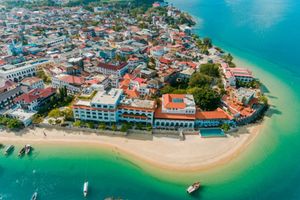How East Africa is faring Malaria

What you need to know:
- Although malaria has become so common that it is less talked about, the reality for some members of the East African community is one for continued concern over this killer disease
Malaria has been one of the biggest scourges on humanity for millennia and mostly kills babies and infants.
East Africa is one of the regions ridden heavily by this disease and over time, efforts to curb the endemic have proven effective in other places while some remain flailing.
Burundi
Spectacular geography of mountains, water bodies, farmlands and cultural diversity make Burundi arguably one of the most stunning countries in East and Central Africa.
Yet nowhere is this splendour more pronounced than in the capital, Bujumbura.
The city hugs Lake Tanganyika on the eastern side and sits on the floor of a series of fringe hills, spreading to the border with Democratic Republic of Congo.
Beneath this beauty, though, lies a dark and dreadful reality, thanks to a high Malaria infection rate in the country. USAID puts Malaria as the leading cause of morbidity and mortality in Burundi. Outbreaks are common.
In 2019, for instance, a Malaria epidemic swept through the Central African nation, with more than 7 million cases and nearly 3000 fatalities.
While other African countries have brought their transmission rates down in the last 20 years, in Burundi, cases of infection have been going in the opposite direction, rising more than twofold two years ago, the Malaria Journal observes.
Like elsewhere in the region, expectant mothers and children aged below five years are the most vulnerable demographic to malaria. Adults too are also at risk.
What makes Burundi so vulnerable to Malaria?
In Burundi, 48 percent of all deaths among children under five are from Malaria.
Data from Burundi’s National Malaria Control Programme shows that 43 percent of all outpatient hospital visits are Malaria-related –even higher among children, at 64 percent.
Though small in landmass, the combination of geography, topography, environmental and human factors in this country makes its population vulnerable to malaria.
High cross-border population movement between Burundi, Uganda, Rwanda and DRC is the biggest headache for authorities in these countries in the fight against Malaria.
Borders between Burundi, Rwanda, Uganda and DRC are some of the most porous in Africa.
According to the Great Lakes Malaria Initiative (GLMI), other key Malaria transmission risk factors in the region are climate change, water bodies and insecticide resistance.
Burundi’s location on the edge of the Tropical Rainforest zone, featuring hot and humid conditions, allows for the breeding and spread of plasmodium falciparum, the parasitic protozoan that causes malaria in humans.
Flooding causes water to collect in pools near residential areas, creating the right environmental conditions for mosquitoes to breed.
A population explosion in the last 20 years has also severely strained the country’s capacity to provide adequate healthcare services to its citizens, complicating the fight against Malaria.
Just outside Bujumbura and resembling a giant green blanket, rice paddies stretch for miles.
A significant proportion of the city’s population works here, growing grain.
Over the last ten years, however, land under rice paddies has been shrinking as more of it is converted into built environment.
Homes have come up everywhere, some of them right inside the paddies.
Kenya
Before the rollout of the malaria vaccine in the country in 2019, data from Jaramogi Oginga Odinga Teaching and Referral hospital indicates that they would admit about five children a day in need of blood transfusion.
However, at the moment, three years after the introduction of the malaria vaccine, the severe cases have gone down.
Several months can pass before a case is admitted to the hospital for blood transfusion.
Kenya has made tremendous progress in the fight against malaria with a number of government-led initiatives being developed over the years with President Uhuru Kenyatta being at the helm of the African Leaders Malaria Alliance (Alma), more goals have been set in the fight against the deadly disease.
Over the years, millions of insecticide-treated bed nets have been distributed and homes fumigated.
Drugs and cheap testing techniques have been made available.
In the year 2000, Supanet, a treated mosquito net, was launched in Kilifi.
It was a new form of intervention as existing nets were not treated.
In April 2001, there was a rebrand as Supanet introduced a retreatment kit dubbed Power Tab.
The tablet would be dissolved in water before the net was dipped in. Soon after though, long-lasting insecticide-treated nets were developed.
Kenya began distributing treated nets in malaria-endemic regions in partnership with the WHO to test their effectiveness.
In 2007, based on the promising results from Kenya, WHO issued global guidance on the use of treated mosquito nets.
Malaria still remains the second biggest cause of reported deaths after respiratory infections, with nearly 70 percent of the country’s 46 million people at grave risk.
Every year, the country reports nearly 3.5 million new clinical cases and 10,700 deaths.
With the introduction of the vaccine RTS,S developed by the pharmaceutical giant GSK and proven effective six years ago, malaria cases fell nationally from a prevalence of 8 percent in 2015 to 5.6 percent in 2020.
In the lake regions, the prevalence has since dropped from 27 percent in 2015 to 19 percent in 2020 and from 8 percent to 4.5 percent currently at the Coast- almost a 50 percent reduction, according to the Malaria Indicator Survey 2020.
The data from the survey shows that malaria cases reduced from 113 per 1000 people to 86 cases per 1000 people.
There are more than 100 types of the malaria parasites.
The RTS,S vaccine targets the one that is most deadly and most common in Africa: Plasmodium falciparum. According to the World Health Organization, the vaccine has the potential to save tens of thousands of lives.
However, it is limited to the poorest parts of the world since it is not clear if it will be feasible to use.
Uganda
It is a country that is slightly over 90 percent malaria endemic; a region with rivers, human activity and poor drainage married to create the perfect breeding ground for mosquitoes which transmit this killer disease.
In the streets, hawkers sell what would be considered a rather unusual commodity; bed nets.
This is where malaria is the leading cause of death and illness which makes it sixth highest killer in Africa with Karamoja region having the highest malaria prevalence among children aged six to 59 months.
Unlike Kenya, where the lake and coastal regions are known to be malaria endemic, in Uganda Karamoja and semi-arid areas which Assistant Commissioner in charge of malaria control at the Uganda Ministry of Health, Dr Jimmy Opigo attributes to the cultural, societal and lifestyle issues of the people.
“There are other unique factors that contribute to high malaria incidences in Uganda,” says Dr Opigo.
The West Nile region in Uganda has registered a large number of cases and deaths here and this is all due to a cash crop most farmers grow.
Tobacco growing is the choice between livelihood and their health and when push comes to shove the people in this area cannot help but seek their livelihoods over the cost to their health.
The farmers in these areas use DDT of which a single genetic mutation causes resistance to DDT and pyrethroids (an insecticide class used in mosquito nets).
This renders the nets issued by the government useless and leaves the people in the West Nile exposed to malaria.
DDT (dichloro-diphenyl-trichloroethane) was developed as the first of the modern synthetic insecticides in the 1940s.
It was initially used with great effect to combat malaria, typhus, and the other insect-borne human diseases among both military and civilian populations.
It also was effective for insect control in crop and livestock production, institutions, homes, and gardens. DDT’s quick success as a pesticide and broad use in the United States and other countries led to the development of resistance by many insect pest species.
Another factor that leads to high cases of malaria and deaths is dense population in areas such as Busoga where the planting of sugarcane and tea is common.
Kampala which is home to the Mulago Hospital, has slightly lower cases of malaria but the hospital administration says that they do see cases of malaria everyday with children and mothers being admitted more than the men.
Net ownership and use varies widely across the regions of Uganda.
A hospital administrator says that clinically diagnosed malaria is the leading cause of morbidity and mortality, accounting for 30 to 50 percent of outpatient visits at health facilities, 15 to 20 percent of all hospital admissions, and up to 20 percent of all hospital deaths.
Malaria also accounts for 27.2 percent of inpatient deaths among children under five years.
Methods such as treated mosquito nets, cheaper testing and treatment, spraying of homes and surrounding environments as well as the roll out of various vaccines have all gone the mile to control and bring down malaria cases.
However, due to the sparse variables in different parts of the region, it comes as no surprise that the fight has to be tailored towards the specific variables.
What remains eminent is the fact that through the many concerted efforts, it is important to pick, learn and tweak lessons and experiences to be effective at all stages.





